What Are Australian Folded Eggs And Are They Worth The Hype?
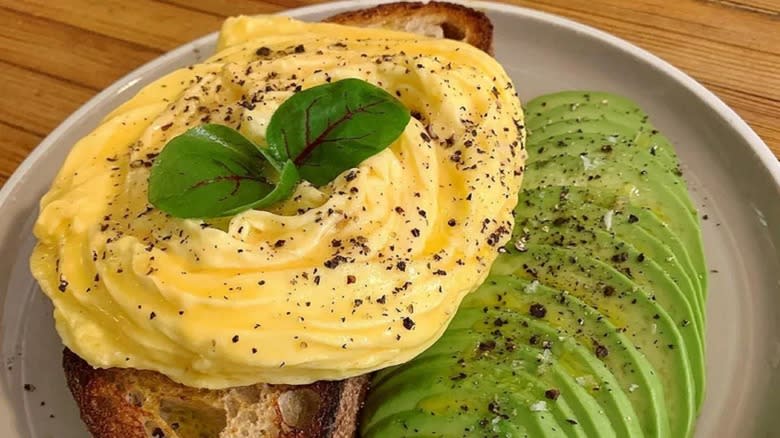
Just when you thought you'd tried every method there is to make eggs, another trend bursts onto the scene to prove that this humble protein is one of the most versatile ingredients out there. One such trend is folded eggs, a method that walks the line between an omelet and a scramble to produce eye-catching ripples of creamy yellow eggs that are so tender they almost melt in your mouth. Videos of folded eggs have racked up tens of millions of views on TikTok, demonstrating just how hot (and ridiculously aesthetically pleasing) this trend is.
As anyone who's tried to make the perfect scramble or produce a symmetrical, mess-free omelet knows, eggs are nowhere near as simple to work with as they appear. Each recipe has its own challenges. With scrambled eggs, the concern is avoiding a rubbery, dry texture. With omelets, it's preventing the filling from falling out and keeping the structure together. Folded eggs are just as difficult. From creating the distinctive rose-like shape to adding just enough cream to make the texture custardy but not enough to prevent the eggs from setting, they take time to master, but the effort that goes into learning this technique pays dividends. Not only are folded eggs beautiful to look at, but as a single, round structure, they are perfect for putting on toast without the usual issue of the eggs sliding off the moment you lift them off the plate. Once you've perfected the technique, you won't look back.
Read more: Ingredients To Take Your Scrambled Eggs To The Next Level
They Are Neither Scrambled Eggs Nor An Omelet

At first glance, folded eggs look a lot like scrambled eggs (albeit the most gorgeously rippled scramble you've ever seen). With an even golden color and soft texture, they are, just like scrambled eggs, made by whisking raw eggs and cooking them in a hot skillet. Unlike scrambled eggs, they are not continuously stirred and pushed around the pan to create a soft curd-like structure. Instead, they are left undisturbed like an omelet until they begin to bubble in the center.
Unlike omelets, however, folded eggs do not have filling and are not made by folding the egg over on itself to form a half-circle once the bottom has set. Instead, when bubbles form in the center of the eggs indicating that the bottom is cooked, the skillet is tilted gently to one side while the cooked portion of the egg is pushed in the opposite direction. This creates space for the uncooked egg to flow and make direct contact with the hot skillet. The action is repeated until the eggs are fully cooked but tender, resulting in a dish that is delicately layered and cooked into one continuous structure.
They Are Not The Same As McDonald's Folded Eggs
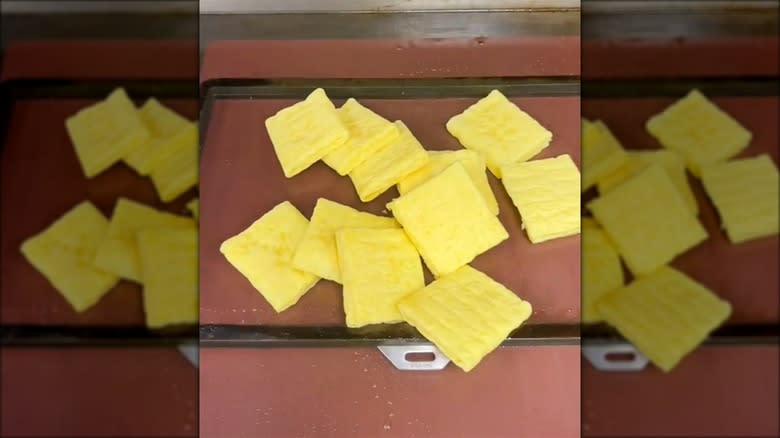
If you've ever come across folded eggs outside of TikTok, it was probably at McDonald's where folded eggs are the default offering when you purchase a McGriddles, a Bacon, Egg & Cheese Biscuit, or a Sausage Biscuit with Egg. The trouble with these folded eggs is that customers don't seem to like them very much. Unlike the round eggs, which are freshly cracked and cooked before being transferred to your bread of choice, folded eggs arrive at the restaurant pre-cooked and frozen and are reheated on the grill before being added to your meal. They are known for their rubbery, even cardboardy texture that isn't exactly mouthwatering, and for many customers, the best option is to request that these precooked sheets of neatly folded egg be substituted with the freshly cracked round ones.
For this reason, the very mention of "folded eggs" might conjure a grimace, but let us assure you that the McDonald's version has absolutely nothing to do with the Australian version. For starters, the Australian version is not precooked and has no trace of rubberiness. It also doesn't even involve folding. Instead, Australian folded eggs are made by gently pushing the egg around the skillet.
Speed And Heat Are Essential
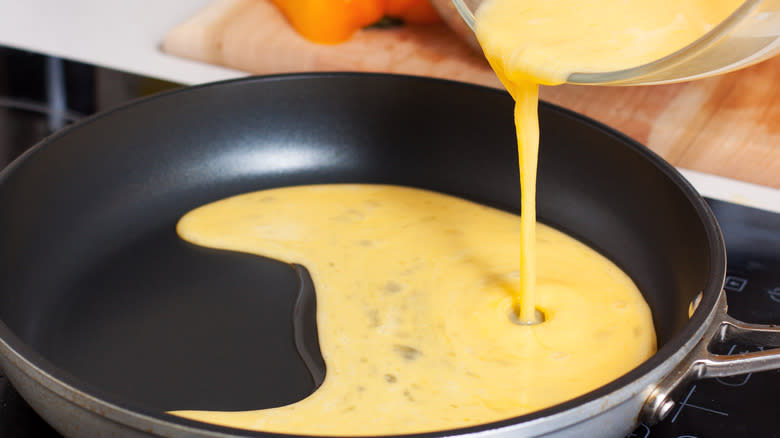
Some recipes are challenging because they require a lengthy process with many steps. Folded eggs come with a different problem -– they require speed. Once you've poured the whisked eggs into the pan, you only have about 15 seconds before you need to push them to another part of the skillet, and then only about 5 seconds between each successive relocation. All in all, it should take less than a minute to make this recipe, so you'll have to be ready and focused as soon as the eggs hit the pan. Make sure you have a spatula in your hand so you aren't fumbling around in your utensils drawer as the eggs are setting, and put a plate next to the stove before you begin so that you'll have a place to transfer the eggs as soon as they're finished.
The other essential element is heat. Folded eggs must be cooked at just the right temperature to fully set on the bottom without burning or cooking on top. High heat is preferable, and your pan should be hot before you add anything to it. Once you add the butter or oil, wait about 15 seconds. You'll know your pan is not hot enough if it takes more than 15 to 20 seconds for the bottom of the eggs to set.
Added Fat Is The Secret Ingredient
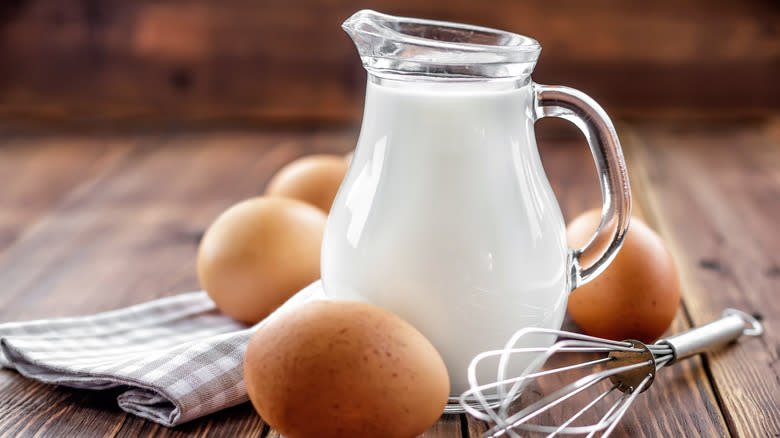
There are many liquid ingredients that you can add to scrambled eggs to make them fluffier, tastier, and more visually appealing. Out of all of them, water might just be the best option thanks to its ability to make the curds puffy and light with steam. When it comes to folded eggs, however, cream is the only liquid you'll need. With its high fat content and velvety texture, it makes the eggs custardy rather than chewy or dense. If you only have milk or would prefer to use it for health reasons, you will still end up with tasty results, but you won't have that decadent texture that cream provides.
As for how much cream you should use, there is some wiggle room. Some recipes call for a scant 2 tablespoons for two eggs, while others call for as much as a ⅓ of a cup. If you want a luxurious, custardy texture, you'll want to err on the side of the latter amount. If you're less concerned with a delicate texture and more concerned with keeping them as healthy as possible, err on the side of the former. Whatever you do, don't use water.
High-Quality Ingredients Are Crucial
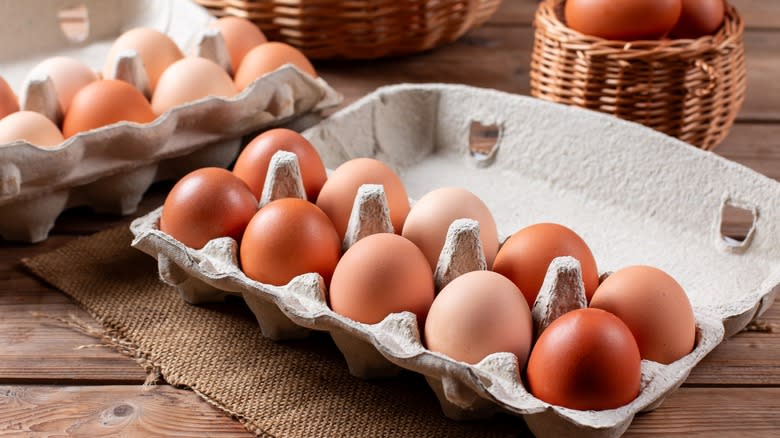
Whenever you're making a recipe with few ingredients, quality is essential. A classic Caprese salad hinges on the freshness of its tomatoes, basil, and mozzarella. Grilled fish will only taste as good as the quality of the fish itself. And eggs, whether scrambled, poached, or boiled, need to be high quality if they're going to taste delicious. You can poach an egg to runny, perfectly formed perfection, but if the yolk is pale and flavorless, you won't be able to appreciate your work nearly as much as you would if you were using farm-fresh eggs.
Folded eggs have four ingredients –- eggs, cream, butter, and salt. You don't have to purchase the most expensive jar of salt at the supermarket for this recipe, but this is the time to splurge on high-fat butter, cream from grass-fed cows, and pasture-raised eggs if possible. The best eggs come from pasture-raised hens who are able to supplement their soy or corn-based diets with protein-rich bugs. Opt for "range-free" or "pasture-raised" rather than "cage-free," since the latter category often entails chickens that are cooped up indoors with little room to move. "Pasture-raised" indicates the highest level of space and outdoor time. You should also keep an eye out for the letter grade that appears on each carton. AA denotes the highest quality, while B is more commonly used for baking.
You'll Need A Few Specific Tools
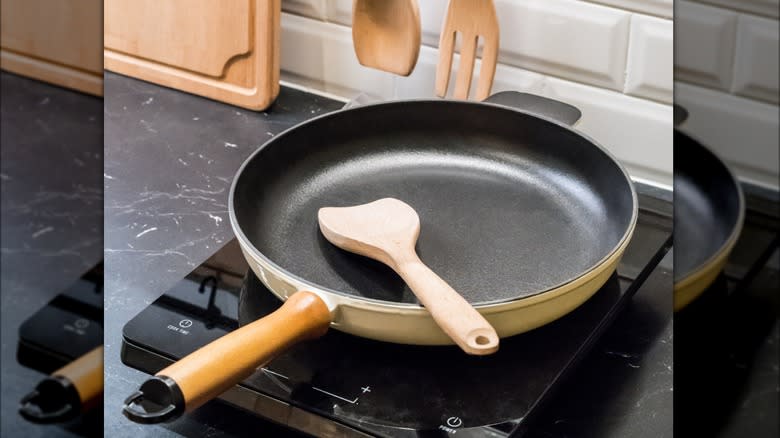
Just as the ingredients are sparse, the tools you need for making folded eggs are minimal yet specific. First, you'll need a non-stick or cast iron skillet. The recipe hinges on being able to push the eggs around the pan without anything sticking to the bottom, and extra butter or cooking spray in a standard pan will not be sufficient. There are pros and cons to using non-stick or cast iron skillets. Non-stick skillets are, as their name suggests, second to none when it comes to preventing food from gluing to the bottom, but they do not do well in high temperatures. When placed over high heat (500 to 600 degrees Fahrenheit), the coating that keeps food from sticking can start to release chemicals into the food. Cast iron skillets are less proficient at avoiding sticking, but they allow you to use higher heat, which in turn helps prevent sticking by creating a quick seal on the food.
The second tool you need is a stiff rubber spatula. As the eggs cook, you have to move quickly, and you don't want your spatula to bend and wobble the moment you try to push the eggs around the pan. Some recipes even call for using a wooden paddle for the task.
Remove Them From Heat Before They're Fully Cooked
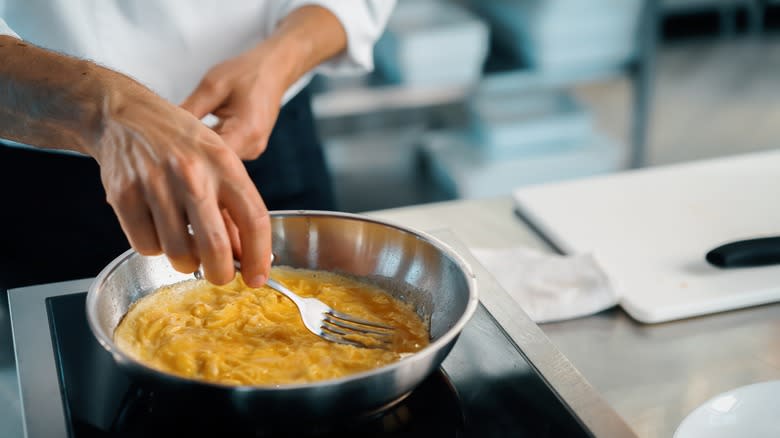
A trademark of folded eggs is their custardy texture. Cream is partly responsible, but the other factor is timing. Removing the pan from the heat when the top of the eggs are still glistening and unset is the key to a perfectly cooked, creamy texture. It might sound ill-advised to leave the eggs partially raw, but most of us happily eat raw yolks all the time when consuming poached eggs, and the principle here is no different. Wait until the eggs are about 95% done, then immediately transfer them to a plate. As they cool, they will continue to cook.
If you're not sure what "95% done" looks like, go by timing instead. From the moment you pour the eggs in the pan to the moment you transfer them to a plate, it should only take about 40 seconds. If your pan is hot, this is plenty of time to cook the eggs just enough without making them rubbery.
It Takes Practice To Master The Rose Shape
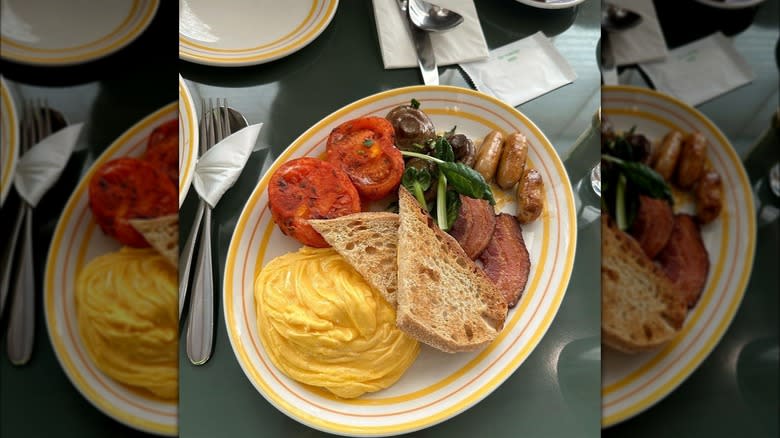
Folded eggs are more of a technique than a specific shape, but if you look at pictures of them online or go to a café that specializes in making them, you'll notice that they have an almost floral shape. Round, with slanted ripples forming tight, petal-like concentric circles, they look like a work of art more than breakfast. Few of us who make folded eggs at home produce this floral appearance for the first time. Or the second. It takes practice and a particular technique when tilting the pan.
You can make perfectly delicious folded eggs without the rose shape, but if you want that striking visual element, you have to tilt the pan in a circle, one step at a time, pushing the eggs into a spiral. Think of the pan as being divided into quarters and push the eggs to each quadrant in turn, moving in a clockwise direction (or counterclockwise if that feels more natural). Depending on how much egg mixture you have, you might travel around the quadrants of the pan two or three times. By the time the eggs are set, you'll have a picture-perfect rose shape.
One Man Is Credited With Igniting The Trend
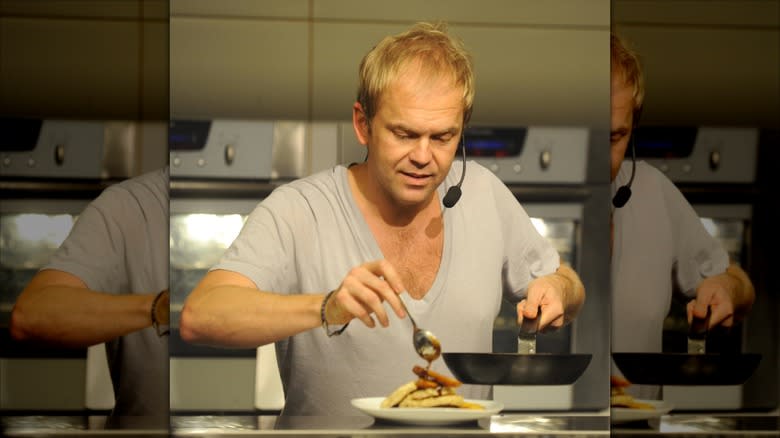
It's difficult to trademark a technique for making eggs, but if anyone could lay claim to folded eggs, it's Bill Granger, the late restaurateur who introduced the world to these custardy disks way back in the '90s at his flagship Sydney café, bills. After the resounding success of the restaurant (aided not least by its popularization of the modern social-media-friendly version of avocado toast), other establishments began creating their renditions of the eggs. The New York Times dubbed Granger the "Egg Master of Sydney," and reported that the Times of London had described his signature dish as the best eggs in the world.
According to the man himself, however, the eggs were almost an accident. When bills opened in 1993, it was a small operation and Granger was by himself in the kitchen. As the customers began flowing in, he had to work quickly, and folded eggs were the technique that evolved for the sake of efficiency. According to Granger, he decided to add a bit of cream and kept adding more and cooking faster, until eventually he was using a ⅓ of a cup for every serving and taking only 40 seconds to make.
They Aren't Limited To Australia

Because of bills' influence and the explosion of similar establishments around the country, folded eggs are often referred to as "Australian folded eggs," but they can now be found all over the world in the trendiest cities. In New York, for example, all-day Australian-style cafés began popping up in the 2010s, offering up colorful brunches of avocado toast, latte art, and, of course, folded eggs. In London, you can enjoy the famous eggs at the various Ottolenghi outposts owned by celebrity chef Yotam Ottolenghi.
Bill Granger's eponymous restaurant has spread as well. You can now find bills and its famous eggs in London, Seoul, and several cities around Japan. If you don't live in a trendy culinary hotspot and don't have access to expertly crafted folded eggs, do not despair. You may not be able to snap a world-class photo with perfectly lit table settings, but you absolutely can master the art of this luscious egg recipe in the comfort of your own home.
Cafés Have Their Own Takes On The Formula
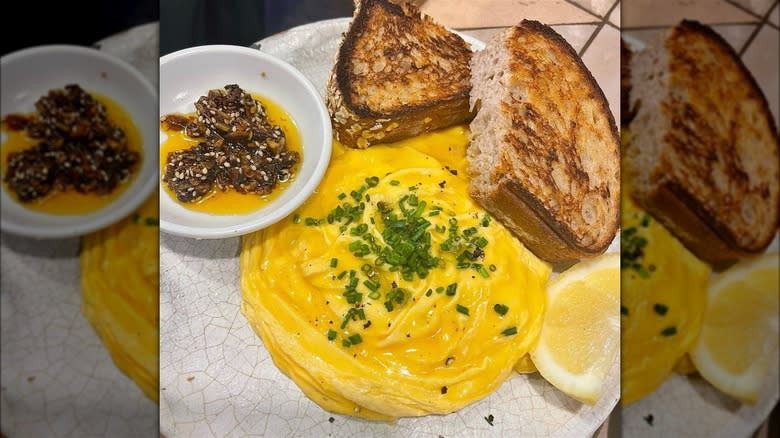
Given how far this Australian recipe has traveled since the '90s, it's no surprise that there are many variations. Some restaurants cook their folded eggs to exquisite, rose-shaped perfection, while others opt for wispier, more tightly coiled folds. Others have pushed them closer to scrambled eggs, where the only thing that marks them as folded eggs is their weightless, custardy texture and continuous shape.
More importantly for home cooks, however, restaurants have taken their own approaches to ingredient pairings. No matter how much you like eggs, you probably aren't content to eat a plate of fluffy scrambled eggs on their own. At Piña, a restaurant in Sydney, the folded eggs are sprinkled with green onions and served with only toast and chili oil. At Two Hands, a brunch chain with restaurants in several cities around the U.S. including New York, Nashville, and Austin, the folded or "ribboned" eggs are served on sourdough toast with marinated peas, fennel, mint, snap pea salad, balsamic, and feta cheese. Meanwhile, at Ottolenghi in London, they're served with cured salmon, grilled focaccia, and a dollop of crème fraîche. As this range suggests, folded eggs are a highly versatile food that can fit into just about any breakfast menu. Serve them with greens, smoked bacon, fruit salad, or toast, and you're bound to enjoy the results.
You Can Add Ingredients To The Recipe
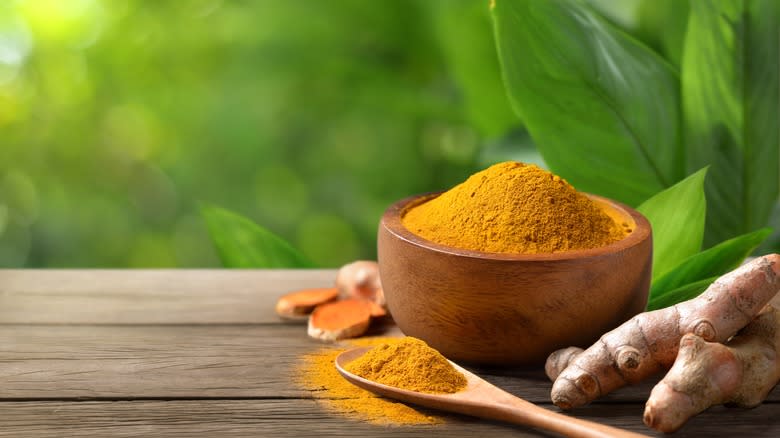
Folded eggs come together so quickly that you'll want to get all the components of the meal together before whisking the eggs. Once you have your toast, salad, bacon, or whatever you're serving them with prepped and plated, it's time to get the pan heated and the eggs mixed. The basic recipe calls for butter (for the skillet), eggs, cream, and salt. Since the texture is of utmost importance, it's best to leave out bulky or dense ingredients like veggies, but there are ingredients you can add if you want to mix things up a bit.
A few grinds of black pepper is an easy and risk-free option, while a scant sprinkling of Parmesan will add a cheesy umami flavor. You can also add a little garlic or chili powder, though it's best to stay away from the fresh, chopped versions of these ingredients to avoid burning them or compromising the texture of the eggs. If you want to make the eggs even more aesthetically pleasing, you can add a dash of turmeric. A minimal amount will not have a detectable flavor but will add to the golden color. This is particularly advantageous if you're using lots of cream since it dilutes the color of the egg yolk.
There Are Pros And Cons To Australian Folded Eggs
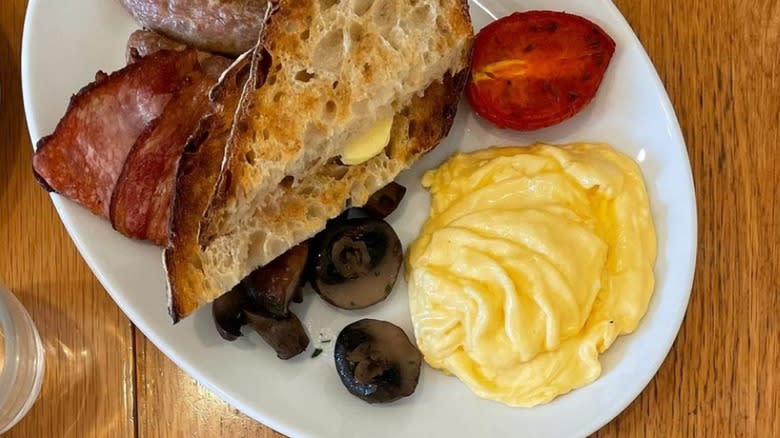
When choosing how you're going to prepare eggs, it's useful to take stock of the upsides and downsides of each option. Folded eggs have many upsides. For one thing, they put an everyday omelet or scramble to shame with their beautifully symmetrical, rippled appearance. For another, they have a luxuriously delicate, custardy texture that is as rich as it is light. They hold their shape when you put them on toast, and take less than a minute to make. They don't require fancy equipment or any of the nail-biting drama of egg poaching. In fact, once you get the hang of how to make them, they're one the most efficient ways to make eggs, and almost certainly the most attractive.
There are downsides, though. You can't fill folded eggs with veggies and cheese as you can with omelets, and you can't even scatter a few tablespoons of diced onions or shredded cheddar without compromising the texture. It is also impossible to make more than one serving at once since the process involves pushing the mixture around the pan to form a single disk. As a result, it might actually take longer to cook folded eggs than scrambled depending on how many people you're making them for. Caveats aside, it's impossible to deny that folded eggs are worth the hype and well worth the effort of learning how to make and judging them for yourself.
Read the original article on Mashed

